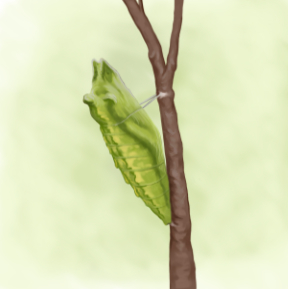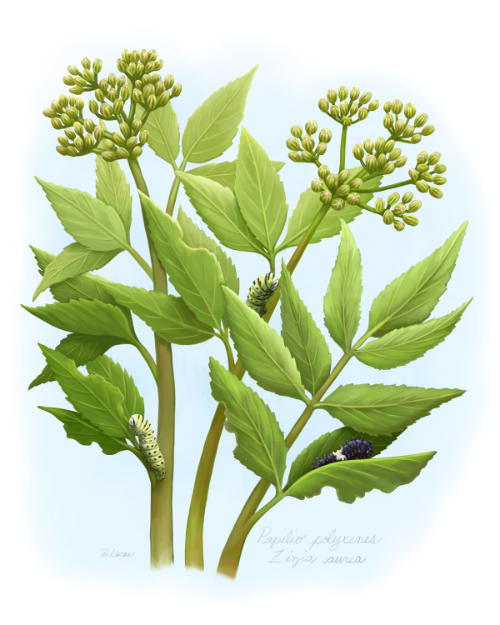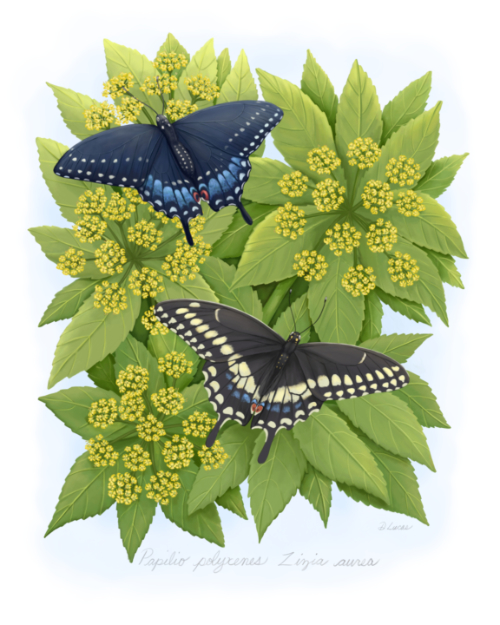Black Swallowtail – Papilio polyxenes
Black Swallowtail butterflies are large butterflies that belong to the Papilionidae family. Black Swallowtails range throughout eastern North America, in the southwest United States and Mexico, but are not found in Newfoundland and Labrador.
Planting host and nectar plants that Black Swallowtail butterflies need to complete their life cycle, will attract them to your garden. Your garden then becomes a much-needed habitat for the Black Swallowtail and other pollinators. All butterflies and moths require host plants to feed on when they are in the larval (caterpillar) stage. The host plants that the Black Swallowtail caterpillars feed on are the flowering plants in the carrot, parsley or celery family. The female butterfly lays her eggs on the leaves of these host plants.
Caterpillar Host Plant(s):
Apiaceae, also called Umbelliferae, is a family of flowering plants commonly known as the carrot, celery, or parsley family. There are many species of plants in this family. Some of them that are native to North America are Golden Alexanders (Zizia auria), American Angelica (Angelica atropurpurea), Hairy Angelica (Angelica venenosa), Sweet Cicely (Osmorhiza claytonii), and Long-styled Sweet Cicely (Osmorhiza longistylis).
If you have a vegetable/herb garden you may have already encountered the brightly colored Swallowtail caterpillars. Many vegetable and herb garden plants are host plants, so plant plenty to share with the caterpillars. Some are: Dill (Anthem graveolens), Fennel (Foeniculum vulgare), Lovage (Levisticum officinale), Parsnip (Pastinaca sativa), and Parsley (Petroselinum crispum). If you wish to keep them out of your vegetable garden then add some of their native host plants to your pollinator garden. Have at least six host plants because caterpillars have big appetites.
Caterpillars:
The young caterpillars have spiny bodies and are black with a white saddle to resemble bird droppings. The fourth and fifth instars have no spines and are green with black bands and yellow spots. The larval stage lasts ten to thirty days.

Chrysalis:
When the caterpillar is ready to enter the chrysalis stage, it will crawl away from the host plants and attach itself to a branch, twig, or secure surface. The summer chrysalis’ are green, this stage lasts for eight to eighteen days. The fall generation is brown so they are camouflaged in the fall and winter landscape.

Adult Black Swallowtail Butterflies:
There are usually two generations of Black Swallowtails, with adults generally flying from mid-May until late September. They are most numerous in early July until late August when the second brood adults are out. There is a third flight period in southern regions. Adult Black Swallowtail butterflies feed on nectar. Your butterfly garden should have a succession of flowering plants to sustain the butterflies from late spring to the fall. Native plants provide the best nutrition for butterflies. Some of the Black Swallowtail’s favourites are:
Adult Diet/Nectar Plants:
Joe pye weeds (Eutrochium spp.), milkweeds (Asclepias spp.), Purple Coneflower (Echinacea purpurea), thistle (Cirsium spp.), clovers (Trifolium spp.), phlox (Phlox spp.), and blazing stars (Liatris spp.).
What else do Canadian Tiger Swallowtails need for their habitat?
A Mud Puddle – Young male Swallowtails often gather at mud puddles to acquire minerals from the mud that they pass to the females during mating. The minerals become nutrients for the eggs, aiding in their survival.
Make a mud puddle for your butterfly garden by using a bird bath, filling it with ordinary garden soil, a handful of compost, some flat stones for the butterflies to perch on and some water. A bird bath turned into a mud puddle provides a safe puddling place out of reach from roaming cats and dogs.
Shelter – to hide from predators and protect them in bad weather. Shrubs, preferably native, and brush-piles are great shelters for butterflies.
Leaving the Leaves – reducing your lawn, growing more native plants and leaving the leaves in your garden are very important things to do in a wildlife/butterfly garden. There are many different species of insects that shelter, develop and overwinter in the leaf litter. Having leaf litter and plants beneath your trees provides a soft landing and shelter for any chrysalis or caterpillar that may fall.

A Butterfly Garden – is a pollinator/wildlife garden. Never use herbicides or pesticides anywhere near a butterfly garden.
Look but do not Touch – please do not buy butterfly kits or chrysalis’ from commercial breeders or home rear butterflies. This is cruel to the animals, can create unfit populations and spread diseases to the wild species.
Links to find out more about plants native to your area:
Ladybird Johnson Wildflower Center
Canadian Wildlife Federation – native plant encyclopedia

